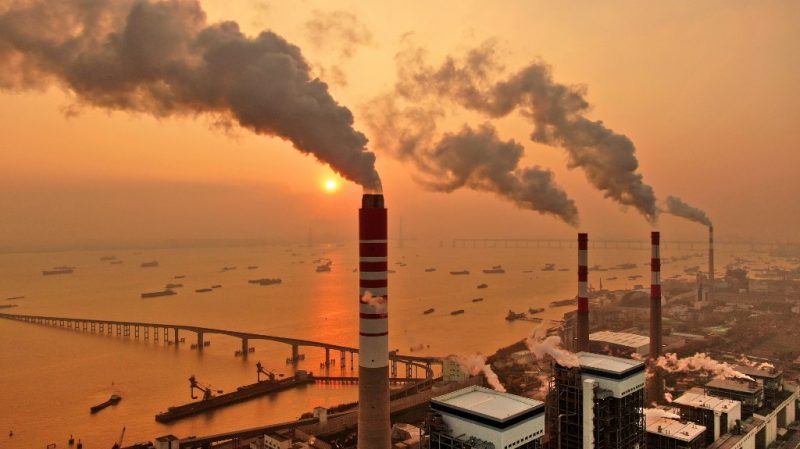Companies in China that fraudulently understate their emissions will face much tougher punishment under new regulations for the country’s national emissions trading system (ETS).
China’s State Council issued new regulations earlier this month, which will be implemented from May 1, according to a report by environmental news-site China Dialogue, which cited the (Chinese language) financial media site 36Kr.
Emissions data fraud has been a big problem for the country’s carbon trading scheme – still in a basic introductory phase – despite the current maximum penalty for any of the 1,833 companies that break the rules being a fine of just 30,000 yuan (about $4,200).
ALSO SEE: Restructuring Firms Busy in Hong Kong Amid China Property Crisis
But from May 1, the minimum penalty will rise to 500,000 yuan – about $70,000.
And if a company is found to broken the new regulations, or an accounting firm produces an emissions report that is fraudulent, “it will forfeit all illegal gains and be fined between five and 10 times those gains.”
At present China’s emissions trading scheme, which opened in July 2022, only covers companies that generate electricity and emit more than 26,000 tons of carbon dioxide a year.
But authorities in Beijing say the scheme will be expanded gradually to include companies from other sectors with heavy emissions.
Focus on long-term transition to clean energy
China has focused so far on installing massive amounts of renewable energy rather than seeking to curb its vast emissions.
According to the International Energy Agency, China boosted its renewable power capacity by 50% to 510 gigawatts last year.
“In 2023, China commissioned as much solar PV as the entire world did in 2022, while its wind [power] additions also grew by 66% year-on-year,” the IEA said.
Carbon Brief, a key NGO monitoring global warming, says it expects China’s CO2 emissions will fall this year, due to the country’s record installation of renewable power, plus “a contraction in demand for carbon-intensive steel and cement due to the ongoing real-estate slump.”
Other positive factors are predicted to be a rebound in hydropower generation, plus a surge of investment in low-carbon technologies, such as solar power, electric vehicles and batteries.
The most obvious negative factor is that “coal power capacity continues to expand”.
China’s power sector emissions of CO2 and other gases were expected to top 4 billion metric tons for the first time last year.
Given that China was battered by multiple extreme events that caused at least $42 billion in damage last year, and the fact that coal power plants are likely to become stranded assets in coming years, this is harder for citizens in other countries to comprehend.
The country boosted its coal-fired power output due to higher demand for heating in winter (and cooling in summer) and the priority that Communist Party leaders put on citizens’ access to power – and limiting any chance of social upheaval.
China’s share of global power sector emissions from fossil fuel use averaged over 41% through the first nine months of the year, according to Reuters, which cited data from the think tank Ember.
But a slow long-term transition is underway. Carbon Brief’s Lauri Myllyvirta has said the positives outnumber the negatives, as a fall in emissions in the power sector – China’s second-largest emitter – plus the cement and steel sectors, likely mean a sustained decline in overall emissions.
“This is because – for the first time – the rate of low-carbon energy expansion is now sufficient to not only meet, but exceed the average annual increase in China’s demand for electricity overall,” he said.
“If this pace is maintained, or accelerated, it would mean that China’s electricity generation from fossil fuels would enter a period of structural decline – which would also be a first.”
Over the first 10 months of 2023, coal accounted for just under 62% of total electricity generation in China. That compares to an average share of about 65% over the previous five years, and more than 71% in 2015, Ember data showed.
Clean electricity supplies – from hydro, nuclear, solar and wind sites – accounted for 35% of total generation by late 2023, compared to 26% in 2015.
Power generators could be punished under new ETS rules
So the big picture is slowly getting better. And the emissions trading scheme should also improve.
Some of the problems of China’s ETS stem from the fact its first set of rules were drawn up by officials from the Ministry of Ecology and Environment.
Why?
It has been difficult for MEE officials to punish companies or individuals that breach these rules because they are regarded as low-level directives, Chang Jiwen, a researcher for the State Council’s Development Research Centre, told Yicai.
The new “Interim Regulations on the Management of Carbon Emissions Trading” state that MEE officials and local authorities will supervise and manage carbon trading activities.
Under the new rules, “if an electricity company does not make corrections, their quota for the next year will be reduced by between 50% and 100%, and they may be ordered to suspend operations until the situation is rectified”.
And people involved in the fraud will be fined and prohibited from any similar work for five years or for life, the China Dialogue report said.
- Jim Pollard with Reuters
ALSO SEE:
China’s New Bonds to Fight Climate Impacts, Lift Recovery
Typhoons, Landslides, Sandstorms Cost China $42bn This Year
Big Clean-up in Hong Kong, Macau, Other Areas After Typhoon Saola
Impact of Floods in China From Typhoon Doksuri Rises
Typhoons, Floods, Heatwaves Cost China Economy $5.7bn in July
























